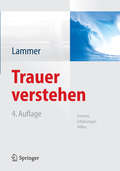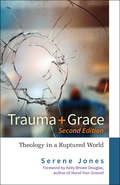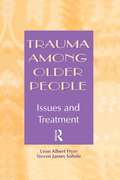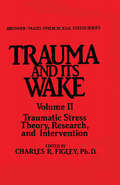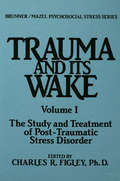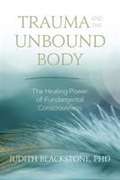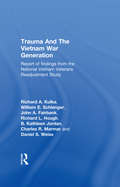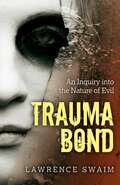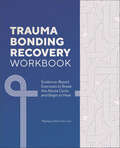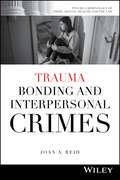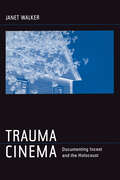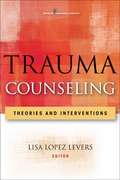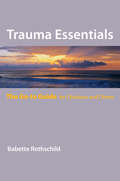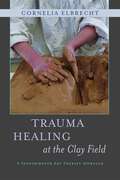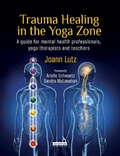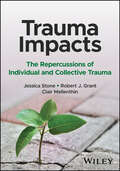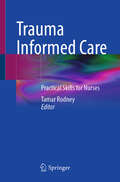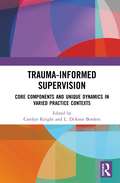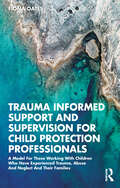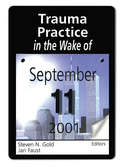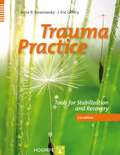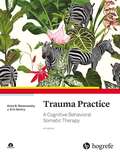- Table View
- List View
Trauer an Schulen: Basiswissen und Hinweise zum Umgang mit Sterben und Tod
by Matthias Böhmer Georges SteffgenDas Buch befasst sich mit dem Umgang mit Trauer an Schulen. Es werden Trauerreaktionen von Kindern und Jugendlichen beschrieben und Trauergründe dargestellt: Tod aufgrund einer chronischen Erkrankung, plötzliche Todesfälle wie Suizid, Unfall und schwere zielgerichtete Gewalt. Entsprechende Interventionsmaßnahmen werden vorgestellt. Abschließend wird auf die Grenzen dieser Interventionsmaßnahmen in der Schule eingegangen.
Trauer in Zeiten der Corona-Krise: Eine qualitative Untersuchung zum Trauererleben weiblicher Adoleszenter während der Covid-19-Pandemie (BestMasters)
by Davina KlevinghausDie Covid-19-Pandemie tangiert das Alltagserleben zahlreicher junger Menschen in Deutschland mitunter gravierend. Wie kann es unter diesen Umständen gelingen, die Trauer nach dem Verlust einer nahestehenden Person in ein von Unabwägbarkeiten und radikalen Veränderungen geprägtes Leben zu integrieren? Welche Belastungen und Ressourcen rücken in Anbetracht der ubiquitären Bedrohung durch das Coronavirus besonders in den Fokus? Auf diese Fragen sowie auf weitere Spezifika des Trauererlebens weiblicher Adoleszenter im Zuge der Pandemie wird - rekurrierend auf Bezugstheorien der Trauer- und Stressforschung - der Schwerpunkt der vorliegenden Arbeit gerichtet. Die geführten Interviews deuten auf erhebliche interindividuelle Unterschiede im Pandemie- und Verlusterleben sowie in den Verarbeitungsformen der eigenen Trauer hin. Zugleich lassen sich zahlreiche geteilte Erfahrungen rekonstruieren. Insofern bieten die Analysen einen grundlegenden Reflexionsanlass im Hinblick auf die Partizipationsmöglichkeiten junger Menschen, den Zugang zu trauerbezogenen Unterstützungsangeboten sowie auf den gesamtgesellschaftlichen Umgang mit Sterben, Tod und Trauer.
Trauer verstehen
by Kerstin LammerTrauer verstehen Trauernden wirksam helfen, ihren Verlust zu bewältigen und sich in einer veränderten Lebenssituation neu zu orientieren - das leistet professionelle Trauerbegleitung. Wie das geht, zeigt dieses Buch. Kurz und bündig werden die Ergebnisse neuerer internationaler Trauerforschung aufbereitet und zu einem Praxismodell entwickelt. Drei Querschnitte präsentieren: - Studien, die Formen der Trauer beschreiben, - Theorien, die Trauer psychologisch erklären, - Modelle, die Trauer bewältigen helfen Mit vielen Schaubildern und Beispielen aus der Praxis. Formen, Erklärungen, Hilfen Der Leser, die Leserin findet ein verständliches Buch, das mit Mythen über Trauerprozesse aufräumt und eine hilfreiche Basis für die Bewältigungsarbeit mit Betroffenen sein kann. Die Autorin identifiziert Aufgaben, die Trauernde nach dem Verlust eines für sie bedeutsamen Menschen bewältigen müssen. Sie entwickelt daraus - als geeignetere Alternative zu gängigen Phasenmodellen - ihr Aufgabenmodell der Trauerbegleitung: - Tod begreifen helfen (Realisation) - Reaktionen Raum geben (Initiation) - Anerkennung des Verlusts äußern (Validation) - Übergänge unterstützen (Progression) - Erinnern und Erzählen ermutigen (Rekonstruktion) - Risiken und Ressourcen einschätzen (Evaluation) Eine praxisnahe Basis für die professionelle Beratung Trauernder
Trauer verstehen: Formen, Erklärungen, Hilfen
by Kerstin LammerTrauer verstehenTrauernden wirksam helfen, ihren Verlust zu bewältigen und sich in einer veränderten Lebenssituation neu zu orientieren – das leistet professionelle Trauerbegleitung. Wie das geht, zeigt dieses Buch. Kurz und bündig werden die Ergebnisse neuerer internationaler Trauerforschung aufbereitet und zu einem Praxismodell entwickelt. Drei Querschnitte präsentieren: - Studien, die Formen der Trauer beschreiben,- Theorien, die Trauer psychologisch erklären,- Modelle, die Trauer bewältigen helfenMit vielen Schaubildern und Beispielen aus der Praxis.Formen, Erklärungen, HilfenDer Leser, die Leserin findet ein verständliches Buch, das mit Mythen über Trauerprozesse aufräumt und eine hilfreiche Basis für die Bewältigungsarbeit mit Betroffenen sein kann. Die Autorin identifiziert Aufgaben, die Trauernde nach dem Verlust eines für sie bedeutsamen Menschen bewältigen müssen. Sie entwickelt daraus – als geeignetere Alternative zu gängigen Phasenmodellen – ihr Aufgabenmodell der Trauerbegleitung:- Tod begreifen helfen (Realisation)- Reaktionen Raum geben (Initiation)- Anerkennung des Verlusts äußern (Validation)- Übergänge unterstützen (Progression)- Erinnern und Erzählen ermutigen (Rekonstruktion)- Risiken und Ressourcen einschätzen (Evaluation)Eine praxisnahe Basis für die professionelle Beratung Trauernder
Trauma Among Older People: Issues and Treatment
by Leon Albert Hyer Steven SohnleTrauma Among Older Adults presents an integrative model of treatment that considers current theories of treatment in light of special considerations relating to elderly patients. The book provides case studies, vignettes, and discussions, and demonstrates the importance of considering the personality, memory, and familial history of an elderly individual who has suffered a trauma.
Trauma And Its Wake (Psychosocial Stress Series #Vol. 4)
by Charles R. FigleyFirst published in 1987. Trauma and Its Wake, Volume II: Post-Traumatic Stress Disorder Theory, Research, and Treatment is the eighth book in the Psychosocial Stress Book Series. The purpose of the Series is to develop and publish books that in some way make a significant contribution to the understanding and management of the psychosocial stress reaction paradigm. The books are designed to advance the work of clinicians, researchers, and other professionals involved in the varied aspects of human services. The primary readership of this Series includes those practitioners, scholars, and their students who are committed to this purpose. The origin of this current book can be traced to Volume #4 in the Series, Trauma and Its Wake: The Study and Treatment of Post-Traumatic Stress Disorder, edited by Charles R. Figley. This was the first attempt to generalize research and clinical findings among a wide variety of traumatic or catastrophic events towards a generalized view of traumatic and post-traumatic stress reactions. Chapters focused on the immediate and long-term psychosocial consequences of exposure to one of many types of catastrophic events: war, rape, natural disasters, incest. Other chapters focused on effective methods of treating or preventing stress reactions or disorders. It is the first in a series of books that will review the latest innovations in theory, research, and treatment of post-traumatic stress disorder (PTSD), caused by a wide variety of stressful life events. The book you are reading is the second of this series of annually published volumes on PTSD within the Book Series.
Trauma And Its Wake (Psychosocial Stress Series)
by Charles R. FigleyPublished in the year 1985, Trauma and its Wake is a valuable contribution to the field of Counseling and School Psychology.
Trauma And The Unbound Body: The Healing Power Of Fundamental Consciousness
by Judith Blackstone“Just as an open hand is hidden within a fist, our true nature, with its innate capacities for happiness, love, and wisdom, is hidden within our pain and numbness. Just as we can open a fist to reveal a hand, our unbound, unconstructed being can emerge from our pain and breathe again.” —Dr. Judith Blackstone, Trauma and the Unbound Body Heal trauma. Reclaim your body. Live with wholeness. These are the gifts of utilizing the power of fundamental consciousness—a subtle field of awareness that lies within each of us. In Trauma and the Unbound Body, Dr. Judith Blackstone explores how we can resolve the mental, physical, and emotional struggles of trauma through the power of fundamental consciousness. Dr. Blackstone weaves her 30-plus years of psychotherapy practice to present a simple yet revolutionary approach to healing trauma. She writes, “All of the constrictions in our fascia (the connective tissue surrounding muscles and organs) are moments of our past that we have stopped in their tracks and held in that way, unconsciously. They are frozen moments of our past.” Trauma and the Unbound Body explains how and why the body constricts in response to trauma, causing physical and emotional pain. Dr. Blackstone guides us through step-by-step processes to unwind those constrictions by attuning to fundamental consciousness, setting the body free of trauma once and for all by uncovering an unbreakable, unified ground of being. In Trauma and the Unbound Body, Dr. Blackstone discusses: ? The five main purposes for bodily constriction—and how to release them to return to wholeness ? How to inhabit the body as fundamental consciousness to liberate trauma-based constrictions ? The Realization Process—a meditative practice for embodied spiritual awakening ? Discovering the unified ground of being within the body that enables lasting change
Trauma And The Vietnam War Generation: Report Of Findings From The National Vietnam Veterans Readjustment Study
by Richard A. KulkaSurveys psychiatric disorders among Vietnam veterans.
Trauma Bond: An Inquiry into the Nature of Evil
by Lawrence SwaimIf the world seems more violent these days, it's not your imagination--there's far too much aggression, coercion and deceit. And powerful institutions such as corporations and governments are getting better at hiding and rationalizing the harm they do. But it doesn't have to be that way: Trauma Bond: An Inquiry into the Nature of Evil shows how breaking free of the cycle of aggression and violence starts with you, and can start today. When aggression becomes evil, it turns into an extraordinarily dangerous and malignant force that threatens to destroy the planet. This fascinating book demonstrates at length how aggression and evil replicate themselves in the world, and how we can break free from the toxic cycle of psychological and physical violence. We can begin this process today, in order to make this world safer, both for ourselves and for our children.
Trauma Bonding Recovery Workbook: Evidence-Based Exercises to Break the Abuse Cycle and Begin to Heal
by Nashay LorickOvercome toxic relationship bonds and begin to heal Freeing yourself from a trauma bond can feel overwhelming. But with the right tools, you can let go of the past and move forward to a brighter future. This supportive workbook is filled with evidence-based strategies and exercises to help you break the cycle of abuse and thrive.Understand your experience—Learn what trauma bonding is and gain insight from the stories of other people who have experienced abuse.Discover tools for healing trauma—Build skills for breaking your toxic relationship with proven exercises like starting a walking meditation practice and rating your level of self-care.Beyond trauma—Explore the aftermath of leaving an abuser, including managing difficult emotions and grief, reclaiming your identity, avoiding relapse, and preparing to move forward with your new life.Empower yourself and take control of your future with this supportive workbook.
Trauma Bonding and Interpersonal Crimes (Psycho-Criminology of Crime, Mental Health, and the Law)
by Joan A. ReidA COLLECTION OF RECENT RESEARCH AND REAL-LIFE REPORTS ON TRAUMA BONDING IN MANY CONTEXTS OF INTERPERSONAL VIOLENCE Trauma bonding, the emotional attachment victims develop toward their abusers or captors, has been repeatedly observed in victims of interpersonal crimes – yet little is known about its formation, persistence, and positive resolution in survivors. Trauma Bonding and Interpersonal Crimes provides a timely review of existing theoretical conceptualizations and research findings on trauma bonding in relation to various forms of interpersonal crimes, including human trafficking, intimate partner violence, child sexual abuse, cults, kidnapping, gang violence, and terrorism. With an accessible and reader-friendly style, lead author Joan A. Reid examines the concept of trauma bonding while offering insights into the consequences of how the phenomenon is framed in the public discourse and the professional sectors. Twelve chapters investigate key topics ranging from methodological issues and research limitations to current debates on victimology within academic disciplines such as criminology, psychology, social work, sociology, and public health. Providing a holistic approach to the subject, Trauma Bonding and Interpersonal Crimes: Highlights the complexities of intervention and treatment for trauma survivors and cliniciansExplores the implications for policy related to trauma bondingRecommends potential avenues for integrated theory and researchFeatures case studies that combine individual examples and evidence-based researchIncludes definitions of terms, critical thinking questions, and further readings in each chapter Part of Wiley’s Psycho-Criminology of Crime, Mental Health, and the Law series, Trauma Bonding and Interpersonal Crimesis an invaluable resource for upper-level undergraduate and graduate students, researchers, policymakers, and practitioners in areas related to victims of human trafficking, intimate partner violence, and child sexual abuse.
Trauma Cinema: Documenting Incest and the Holocaust
by Janet WalkerTrauma Cinema focuses on a new breed of documentary films and videos that adopt catastrophe as their subject matter and trauma as their aesthetic. Incorporating oral testimony, home-movie footage, and documentary reenactment, these documentaries express the havoc trauma wreaks on history and memory. Janet Walker uses incest and the Holocaust as a double thematic focus and fiction films as a point of comparison. Her astute and original examination considers the Hollywood classic Kings Row and the television movie Sybil in relation to vanguard nonfiction works, including Errol Morris's Mr. Death, Lynn Hershman's video diaries, and the chilling genealogy of incest, Just, Melvin. Both incest and the Holocaust have also been featured in contemporary psychological literature on trauma and memory. The author employs theories of post traumatic stress disorder and histories of the so-called memory wars to illuminate the amnesias, fantasies, and mistakes in memory that must be taken into account, along with corroborated evidence, if we are to understand how personal and public historical meaning is made.Janet Walker’s engrossing narrative demonstrates that the past does not come down to us purely and simply through eyewitness accounts and tangible artifacts. Her incisive analysis exposes the frailty of memory in the face of disquieting events while her joint consideration of trauma cinema and psychological theorizing radically reconstructs the roadblocks at the intersection of catastrophe, memory, and historical representation.
Trauma Counseling: Theories and Interventions
by Lisa Lopez LeversTrauma Counseling: Theories and Interventions is a much-needed textbook that focuses on relevant issues of traumatic, crisis-related, and disaster events from a systemic paradigm. The book discusses evidence-based trauma assessment and intervention techniques and integrates the latest findings from neuropsychology and psychopharmacology.
Trauma Essentials: The Go-To Guide (Go-To Guides for Mental Health)
by Babette RothschildBasic information about one of the most common problems in therapy, from a best-selling mental health writer. Since 1980, when PTSD first appeared as a diagnostic category, the number of people seeking trauma therapy has grown exponentially. Victims of traumatic events seek treatment for their often debilitating symptoms. Here, a leading trauma specialist and best-selling psychotherapy author presents for consumers the wide range of trauma treatments available and gives readers tools to choose a treatment plan or assess whether their treatment plan is working. Medications and associated conditions such as anxiety and panic disorders are also discussed. This book presents the most necessary and relevant information in a compact and accessible format, serving both as a review for therapists and a straightforward, easy-to-use guide for patients. Topics covered include definitions and symptoms, accepted treatments, physiological explanations, and treatment evaluation strategies, all written in Babette Rothschild's characteristically accessible style.
Trauma Healing at the Clay Field: A Sensorimotor Art Therapy Approach
by Cornelia Elbrecht Heinz DeuserUsing clay in therapy taps into the most fundamental of human experiences - touch. This book is a comprehensive step-by-step training manual that covers all aspects of 'Work at the Clay Field', a sensorimotor-based art therapy technique. The book discusses the setting and processes of the approach, provides an overview of the core stages of Gestalt Formation and the Nine Situations model within this context, and demonstrates how this unique focus on the sense of touch and the movement of the hands is particularly effective for trauma healing in adults and children. The intense tactile experience of working with clay allows the therapist to work through early attachment issues, developmental setbacks and traumatic events with the client in a primarily nonverbal way using a body-focused approach. The kinaesthetic motor action of the hands combined with sensory perception can lead to a profound sense of resolution with lasting therapeutic benefits. With photographs and informative case studies throughout, this book will be a valuable resource for art therapists and mental health professionals, and will also be of interest to complementary therapists and bodyworkers.
Trauma Healing in the Yoga Zone: A Guide for Mental Health Professionals, Yoga Therapists and Teachers
by Joann LutzThe book describes an original model of nervous-system informed, trauma-sensitive yoga, a synthesis of classic yoga, somatic psychotherapy, and neuroscience research. It is organized around the eight stages of classic yoga practice and includes scripts of chair yoga postures, the three-part deep breath, and the Integral Yoga version of yoga nidra, for use by professionals who are not certified as yoga teachers.The book is needed for three reasons: mainstream psychotherapy has, until recently, ignored the body, a major element in the healing of trauma and other emotional and mental dysregulations. It has also omitted the wisdom from the world's great spiritual traditions, perpetuating an artificial separation between religion/spirituality and science. The field is also currently being enriched by empirical data from the field of neuropsychology that describes brain function. The profession is ready to transform and embrace a holistic model and yoga can play a significant role in that transformation.The book is primarily intended for mental health professionals and yoga therapists and teachers, both civilian and in the military. It could be of interest to professionals in related fields, such as medicine, as well as the general population of people interested in yoga and healing.
Trauma Impacts: The Repercussions of Individual and Collective Trauma
by Jessica Stone Clair Mellenthin Robert J. GrantA systems-oriented look at how unhealed trauma can prevent optimal functioning—and what to do about it Trauma Impacts: Repercussions of Individual and Collective Trauma explores the many ways that traumatic experiences affect people from diverse backgrounds, as individuals and in groups. In chapters contributed by experts in their fields, this book offers a systemic overview of how trauma impacts all humans, then delves into the manifestations of trauma in specific populations like BIPOC communities, neurodivergent children, and those in helping professions. The book's third and final section looks at emerging modalities for working with trauma and implications for the future of trauma-focused therapy. Ideal for anyone who works closely with individuals who have experienced trauma—therapists, educators, social workers, and beyond—Trauma Impacts will benefit from a thorough understanding on how trauma continues to influence lives, even long after the fact. Trauma can interfere with meeting basic needs, forming healthy relationships, and finding fulfillment in the pursuit of individual and collective goals. When we conceptualize these impacts, we become empowered to help people process their traumatic experiences, integrate the pain they have experienced, and lead more satisfying lives. Understand the intersectional effects of trauma on individuals and systems Discover hope for healing through real-world voices and current research Consider how collective trauma manifests in the lives of individuals Gain insights that can help you work more effectively with clients
Trauma Informed Care: Practical Skills for Nurses
by Tamar RodneyThis text outlines a practical guide for nurses and healthcare providers to provide care for individuals with varying traumatic histories with an informed perspective. Consideration of trauma as an acute experience to one that can develop into a post-traumatic stress disorder are explored. Additionally, the biological, behavioral, historical and cumulative basis of trauma are discussed as well as the family’s role in generational trauma. Trauma presents a complex multilayered experience that requires understanding to provide appropriate care. Trauma if often viewed as a physical experience with minimal consideration of the emotional and mental health aspects of these experiences. The perspective of unseen emotional scars is given descriptive graphic to allow the scars to be visualized and treated. The book includes perspectives across the globe from Thailand, UK, Philippines, India, Ireland, and Caribbean. As such this book will fill a gap in the field.
Trauma Informed Supervision: Core Components and Unique Dynamics in Varied Practice Contexts
by Carolyn Knight Di BordersSurvivors of trauma are disproportionately represented in agencies providing a broad range of behavioral, social, and mental health services. Practitioners in these settings must understand and be able to respond to survivors of trauma in ways that are empowering, normalize and validate their experiences and reactions, and minimize the risk of retraumatization. Practitioners also will be indirectly traumatized as a result of their work with trauma survivors. <p><p> Practitioners’ ability to help clients with histories of trauma depends upon clinical supervision that is trauma-informed. The trauma-informed supervisor has the dual responsibility of enhancing supervisees’ skills as trauma-informed practitioners and helping them manage the impact their work has on them. <p> Nevertheless, many clinical supervisors only have limited knowledge and training in trauma and may not recognize either the needs of those whom they supervise or the clients their supervisees serve. This book compiles important recommendations from trauma-informed practitioners, supervisors, and researchers who share their professional reflections and personal stories based on their hands-on experiences across mental health and medical contexts.
Trauma Informed Support and Supervision for Child Protection Professionals: A Model For Those Working With Children Who Have Experienced Trauma, Abuse And Neglect And Their Families
by Fiona OatesThis book presents a narrative approach to creating a supportive environment for health and human service practitioners who work with vulnerable children and their families—one of the most difficult and complex areas of practice. People working in these environments are routinely exposed to violence and trauma and commonly experience symptoms of traumatic stress as a result. Traditionally, human service and health care service organisations have struggled to support practitioners who experience primary and secondary trauma in either a preventative context or post exposure. Using contemporary trauma theory, this book provides a trauma-informed support and supervision framework for supervisors and managers of practitioners that recognises the uniqueness of the practice field, the diversity of practitioners who undertake the work and the diversity of contexts in which they work. It will be required reading for all human service and health professionals, including social workers, psychologists and nurses as well as teachers, counsellors and youth workers.
Trauma Practice in the Wake of September 11, 2001
by Steven N Gold Jan FaustTrauma practitioners and educators: are you ready to meet the challenges of the aftermath of terrorist attacks?Trauma Practice in the Wake of September 11, 2001 will show you how frontline trauma practitioners responded to the crisis of the terrorist attacks. In keeping with Haworth’s mission to provide practitioners and educators with timely information on the assessment and treatment of trauma, this essential book responds to the traumatic impact of the events of September 11th, 2001 and their implications for trauma practice. In Trauma Practice in the Wake of September 11, 2001, you’ll hear from the leaders of the Green Cross--one of the most prominent organizations providing psychological disaster response services--on their experience in the World Trade Center disaster, and read about the treatment of a client who was in the first WTC bombing in 1993. You'll also find revealing interviews with an Israeli psychologist and a Palestinian psychiatrist who focus on the impact of terrorism on their citizens. Trauma Practice in the Wake of September 11, 2001 is your key to state-of-the-art information on: the psychology of terrorism the traumatic impact of terrorism on those directly affected the traumatic impact of terrorism on the general population ways to help children, adolescents, and adults cope with the aftermath of the terrorist attacks on America how to deal with “compassion fatigue” (emotional depletion among helping professionals working with traumatized populations) traumatologists’response to rescue workers and victims in New York CityThe catastrophic events of September 11th have and will continue to raise special challenges for those of us in the field of trauma practice. By publishing this book and the ones to follow, we hope to assist trauma practitioners and educators in effectively meeting these continuing challenges.
Trauma Practice, Third Revised and Expanded Edition: Tools For Stabilization And Recovery
by Anna B. Baranowsky J. Eric Gentry<P>An updated, comprehensive, and essential reference and tool-kit for treating trauma survivors. <P>Filled with new resources, this book based on the tri-phasic trauma treatment model is a guide for both seasoned trauma therapists and newer mental health professionals seeking practical approaches that work.
Trauma Practice: A Cognitive Behavioral Somatic Therapy
by Anna B. Baranowsky J. Eric GentryThis popular, practical resource for traumatologists has been fully updated and expanded. It remains a key toolkit of cognitive behavioral somatic therapy (CBST) techniques for clinicians who want to enhance their skills in treating trauma and for those in training. The authors focus on helping practitioners find the right tools to guide their traumatized clients towards growth and healing but now also lay a deeper emphasis on the preparatory phase for therapists, including the therapists’ own ability to self-regulate their autonomic system during client encounters.


